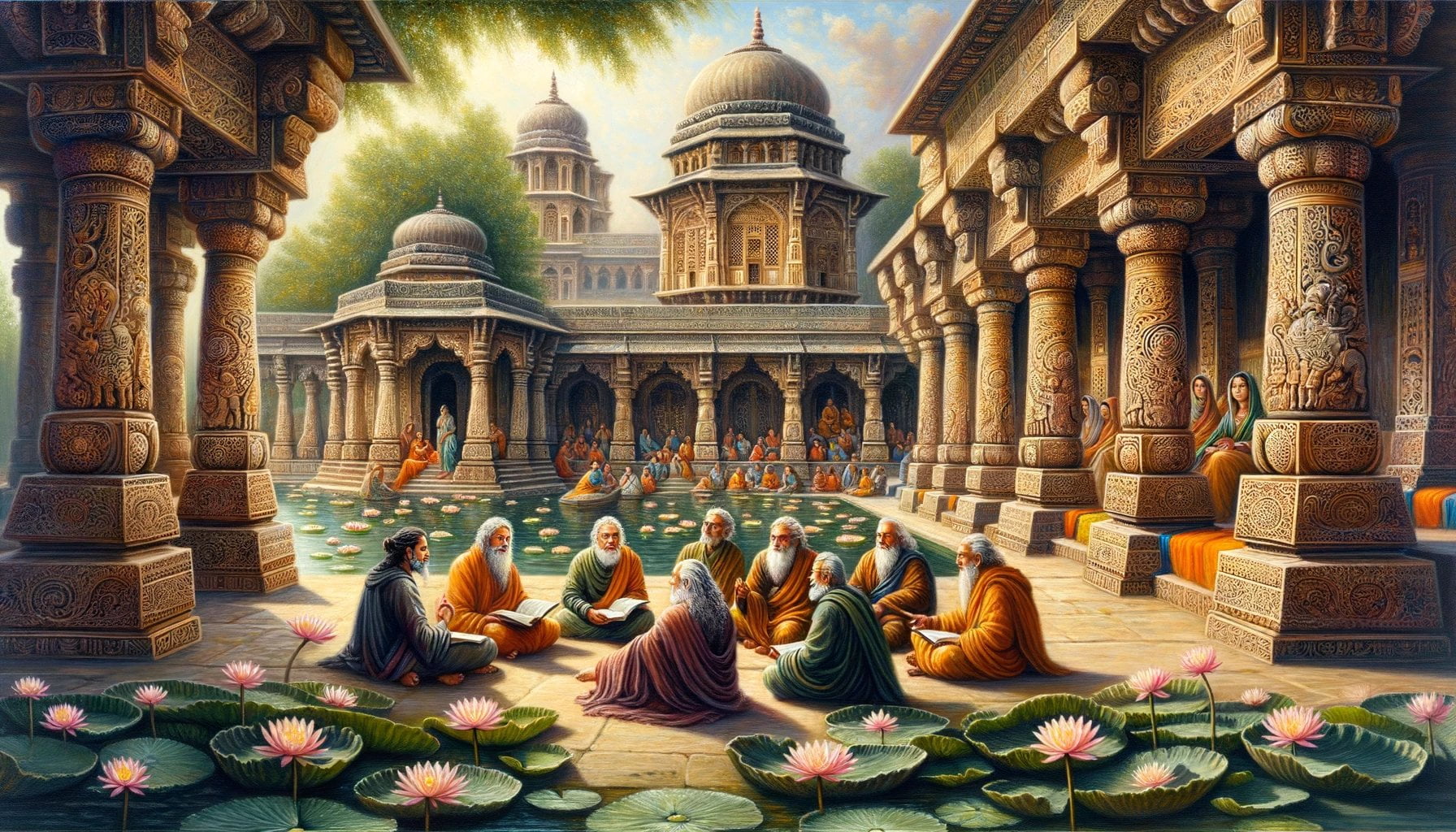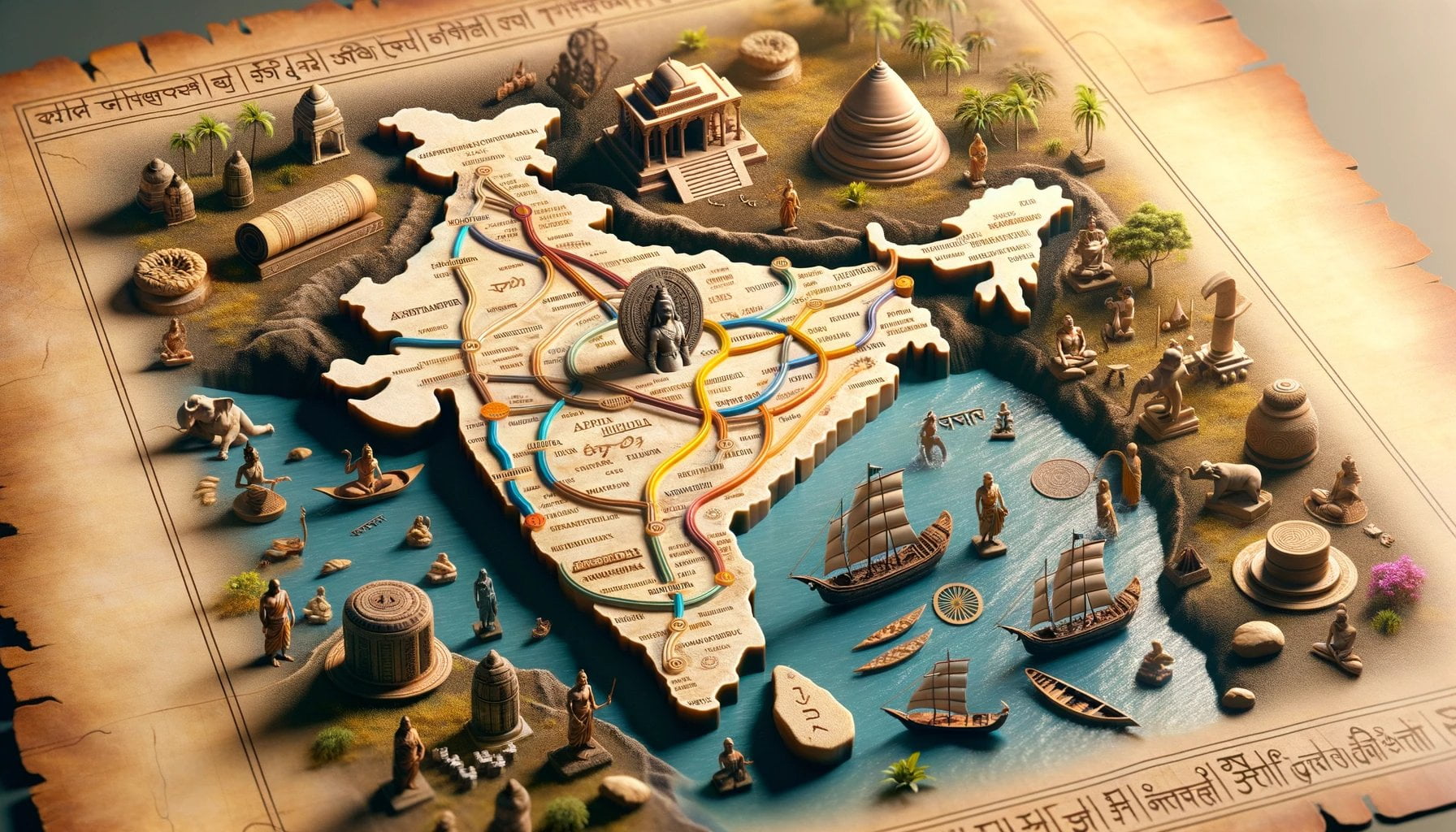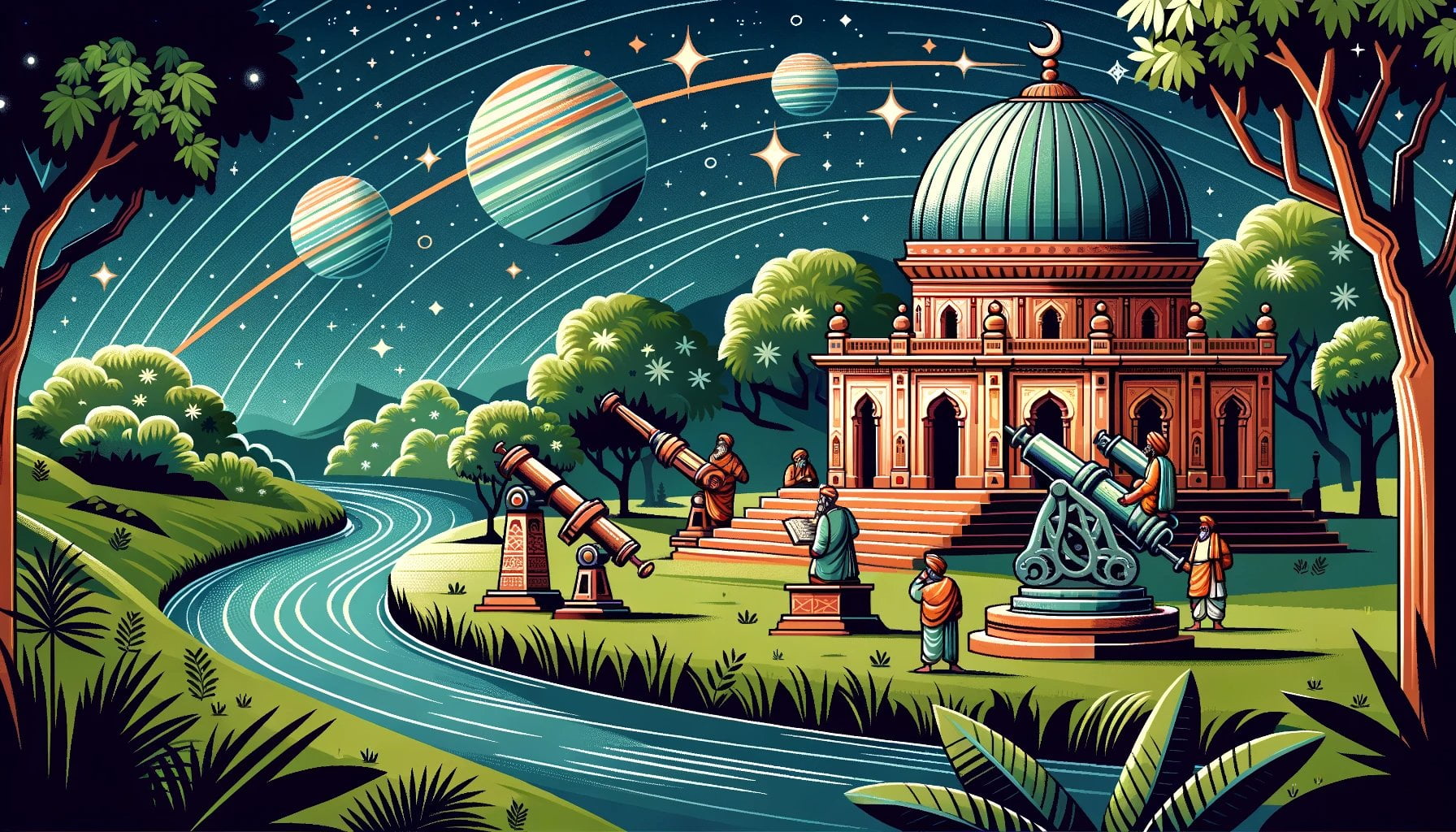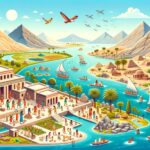Ancient India, a civilization steeped in mystery and awe, has left a profound imprint on human history. In this article, we delve into the extraordinary accomplishments of this enigmatic civilization, particularly in the fields of mathematics, medicine, astronomy, and philosophy. From pioneering mathematical concepts to groundbreaking advancements in healthcare, alongside profound contributions to understanding the cosmos and the development of philosophical and religious ideologies, Ancient India’s achievements continue to awe and inspire us to this day. Join us on a captivating journey as we unravel the profound legacies left behind by this incredible ancient civilization.
Key Takeaways:
– Sanskrit, the earliest modern language, showcased its sophistication through the comprehensive grammar book “Astadhyayi” written by Panini in 400 BC.
– Ayurveda, the earliest school of medicine, introduced holistic healing practices that are still used today, incorporating natural remedies and dietary changes.
– Sushruta, the father of surgery, performed complex surgeries and documented his findings in the book “Sushrutasamhita”, including rhinoplasty and cataract surgeries.
– Yoga, developed by sage Patanjali, combines physical postures, breathing techniques, and meditation to promote overall well-being and is widely practiced worldwide.
– Ancient India made significant inventions, such as cataract surgery, chess, cotton cultivation, flush toilet systems, and weighing scales.
– The Bower Manuscript revealed ancient Indian knowledge of cataract surgery, highlighting their advanced medical expertise.
– Ancient India’s invention of chess has had a profound impact on strategic thinking and remains popular globally.
– Cotton cultivation, pioneered by ancient Indians, revolutionized the textile industry.
– Ancient Indians demonstrated their understanding of sanitation and urban planning through their ingenious flush toilet system.
– Weighing scales developed by ancient Indians showcased their advanced knowledge of mathematics and precision in measurements.
Ancient India Achievements

Ancient India, with its rich heritage and profound intellectual contributions, holds a special place in the annals of history. Let us explore some of the remarkable achievements of this enigmatic civilization in the fields of mathematics, medicine, astronomy, and philosophy.
Mathematics: The Foundation of Numerical Excellence
The Zero Concept: One of the greatest contributions of ancient India to the world of mathematics is the concept of zero. Ancient Indian mathematicians realized the need for a symbol to represent nothingness and developed the numeral “0,” which revolutionized numerical systems and laid the foundation for modern mathematics.
Astounding Number System: Ancient Indian mathematicians also introduced the decimal place value system, which includes the use of digits and positional notation. This innovation made complex calculations more efficient and provided a solid basis for advanced mathematical theories.
Medicine: Healing Wisdom from the Past
Ayurveda: Ancient India gave birth to Ayurveda, the earliest school of medicine, which advocates for holistic healing and natural remedies. This ancient practice emphasizes the interconnectedness of the mind, body, and spirit in achieving overall well-being.
Sushruta’s Surgical Expertise: Sushruta, hailed as the father of surgery, conducted complex surgeries and compiled his findings in the Sushrutasamitha. His pioneering work in the field of surgery included procedures like rhinoplasty and cataract surgeries, displaying the advanced medical knowledge of ancient India.
Astronomy: A Glimpse into the Cosmos
Aryabhata’s Astronomical Advancements: Ancient India gave us Aryabhata, a brilliant mathematician and astronomer. His treatise, Aryabhatiya, introduced revolutionary concepts like the heliocentric model of the solar system and accurately calculated the length of a year.
Intricate Calendar Systems: Another notable astronomical achievement of ancient India is the development of precise calendar systems. The Surya Siddhanta, an ancient Indian astronomical text, provided accurate methods for predicting celestial events and determining auspicious times for religious and agricultural activities.
Philosophy: Shaping Spiritual Traditions
Vedas and Upanishads: Ancient India produced profound philosophical texts known as the Vedas and the Upanishads. These sacred scriptures delve into metaphysical concepts, ethical principles, and the nature of reality, offering profound insights into the human experience.
Buddhism and Jainism: Ancient India gave rise to influential philosophical and religious traditions like Buddhism and Jainism. These belief systems emphasized non-violence, compassion, and the pursuit of enlightenment, shaping the moral and ethical fabric of societies across the world.
In conclusion, ancient India stands as a testament to human ingenuity and intellectual prowess. From its contributions to mathematics, medicine, astronomy, and philosophy, this remarkable civilization has left an indelible mark on our present-day world. As we delve deeper into the achievements of ancient India, we uncover a rich heritage that continues to inspire and shape our modern lives.
| Field | Achievements |
|---|---|
| Mathematics | – Introducing the concept of zero |
| – Pioneering the decimal place value system | |
| Medicine | – Establishing Ayurveda, a holistic healing tradition |
| – Sushruta’s groundbreaking surgical procedures | |
| Astronomy | – Aryabhata’s heliocentric model and accurate predictions |
| – Development of precise calendar systems | |
| Philosophy | – Philosophical insights from the Vedas and Upanishads |
| – Buddhism and Jainism’s influence on ethics and morality |
Government in Ancient India played a crucial role in shaping the civilization. Learn more about the governance system in ancient India and its fascinating aspects by clicking on Government Ancient India.
Discover the intriguing realm of Economics in Ancient India and how it influenced the society by exploring Economics in Ancient India.
Immerse yourself in the incredible stories of Ancient Warriors of India, who showcased unparalleled bravery and skills. Unveil their legendary tales by clicking on Ancient Warriors of India.
Unravel the mysteries of Politics in Ancient India and gain insight into the political system that shaped the nation’s destiny. Delve deep into the intriguing world of ancient Indian politics by clicking on Politics Ancient India.
Contributions to Astronomy and Astrology
Since ancient times, India has made significant contributions to the fields of astronomy and astrology. The ancient Indian astronomers were pioneers in their ability to observe and analyze celestial phenomena. Their discoveries and theories have left a lasting impact on the scientific world.
Link between Astronomy and Astrology
In ancient India, astronomy and astrology were closely intertwined. While astrology aimed to interpret the positions of celestial bodies and their influence on human affairs, astronomy focused on studying the stars and planets in a scientific manner. Over time, the science of astronomy developed independently, but its roots remained connected to astrology.
Ancient Indian Astronomers
Some notable astronomers from ancient India include Brahmagupta, Aryabhata, and Shripati. These brilliant minds made significant contributions to both astronomy and astrology, leaving a profound impact on the field.
Brahmagupta was a 7th-century mathematician and astronomer who made remarkable advancements in the field. He formulated mathematical rules to calculate the occurrences of eclipses and estimated the Earth’s circumference with impressive accuracy.
Aryabhata, born in the late 5th century, devised a heliocentric model of the solar system and calculated the exact length of a year. His groundbreaking work paved the way for future astronomical discoveries.
Shripati, an astronomer who lived during the 11th century, developed sophisticated mathematical models and theories. His contributions enriched both astronomy and astrology, influencing scholars in both the Islamic world and Europe.
Advancements in Ancient Indian Astronomy
Ancient Indian astronomers made several noteworthy advancements that revolutionized the field. They observed the cosmos with great precision and developed sophisticated mathematical concepts and models to understand celestial bodies.
One significant breakthrough was the recognition that the sun was a star. Ancient Indian astronomers were among the first to realize that the sun was not unique but rather a distant object similar to the other stars in the sky. This understanding laid the foundation for further discoveries about our place in the universe.
Another remarkable achievement was the determination of the number of planets in our solar system. Ancient Indian astronomers identified seven main celestial bodies, which included the five visible planets known at that time, along with the sun and the moon. Their accurate observations set the stage for future explorations of our galactic neighborhood.
Legacy and Influence
The contributions of ancient Indian astronomers were not limited to their own time and region. Their research and theories spread far beyond India, influencing scholars in other parts of the world.
The mathematical concepts and models developed by ancient Indian astronomers formed the basis for the Islamic world’s advancements in astronomy. Islamic astronomers built upon the knowledge and theories established in ancient India, further expanding our understanding of the cosmos.
In Europe, these Indian advancements in astronomy had a profound impact on the scientific revolution that took place during the Renaissance. European scholars studied and incorporated the insights of ancient Indian astronomers into their own scientific endeavors, propelling astronomical understanding forward.
Key Takeaways:
- Ancient Indian astronomy had a close connection with astrology, but it developed independently as a scientific discipline.
- Brahmagupta, Aryabhata, and Shripati were significant contributors to ancient Indian astronomy.
- Ancient Indian astronomers were among the first to recognize that the sun is a star and determined the number of planets in our solar system.
- Their advancements in astronomy influenced the Islamic world and Europe, contributing to the overall progress of the field.
Citations:
Development of Influential Philosophical and Religious Concepts
The rich history of Ancient India encompasses a wide range of achievements, from advancements in mathematics, medicine, and astronomy to the development of profound philosophical and religious concepts that continue to shape our modern world. In this article, we will delve into the fascinating realm of the development of influential philosophical and religious concepts in ancient India.
Religious Developments in the Indus Valley Civilization
Even during the Bronze Age, the Indus Valley Civilization witnessed significant religious developments. The city of Mohenjo-daro, meaning “heap of the dead,” provides a glimpse into the religious practices of this enigmatic civilization. Excavations have uncovered archaeological evidence pointing to the worship of a male god known as Pashupati. These findings give us a glimpse into the diverse religious beliefs that flourished in ancient India.
Ancient Symbols and Religious Motifs
Ancient India boasts a rich and diverse tapestry of religious symbols and motifs that have transcended time. One such symbol is the Swastika, which holds significant religious meaning. Dating back to the Neolithic era, the Swastika has been found in the archaeological record, signifying the sacred and spiritual significance attached to this symbol in ancient Indian culture.
The Interplay Between Indian Philosophy and Religion
In ancient India, philosophy and religion seamlessly complemented each other. The systems of Indian philosophy that originated from the Vedas are considered orthodox. These philosophical traditions provided the intellectual framework through which ancient Indians explored the intricate questions of existence, ethics, and morality.
The Influence of European Scholars and Perception of Indian History
During the 19th century, European scholars initially viewed Indian history through the lens of spirituality. They often perceived it as static and solely focused on matters of the spirit. However, as our understanding deepened, we began to recognize the vast contributions ancient India made in various fields, including philosophy and religion.
The Foundation of Hinduism in Ancient India
Hinduism, one of the oldest religions in the world, originated in ancient India and has roots that can be traced back to the Vedic period. It encompasses a complex tapestry of gods, goddesses, rituals, and philosophical ideas. The influence of Hinduism extends far beyond the borders of ancient India, shaping not only the region’s culture but also influencing global philosophical and religious traditions.
Key Takeaways:
- The Indus Valley Civilization witnessed religious developments, with the worship of the male god Pashupati in the city of Mohenjo-daro.
- The Swastika, an ancient symbol, holds religious significance and has been found in the archaeological record dating back to the Neolithic era.
- Indian philosophy and religion are intertwined, with orthodox systems of philosophy originating from the Vedas.
- European scholars initially perceived Indian history as static and focused on spirituality, but later recognized the diverse contributions of Ancient India.
- Ancient India laid the foundations of Hinduism, a complex religion with a profound influence on both regional and global scales.
Sources:
– World History Encyclopedia – Ancient India
– Britannica – Indian Philosophy
The establishment of a sophisticated urban civilization
The Indus civilization, also known as the Indus Valley civilization or Harappan civilization, is a fascinating chapter in ancient Indian history. Let’s delve into its remarkable achievements and uncover the secrets of this sophisticated urban civilization.
The Indus Civilization: A Remarkable Urban Culture
The Indus civilization emerged around 3300 BCE in the Indian subcontinent and lasted until 1300 BCE. Spanning across present-day Pakistan and northwest India, this urban culture left behind a rich legacy of accomplishments.
Advanced Town Planning and Infrastructure
One of the most striking aspects of the Indus civilization is its sophisticated town planning. The cities of Harappa and Mohenjo-daro, along with smaller towns and villages, showcased precise urban layout and infrastructure.
– Grid-like Street Patterns: The cities were laid out in a grid-like pattern, with well-organized streets running perpendicular to each other. This layout not only facilitated efficient movement but also allowed for better drainage systems.
– Sanitation Systems: The Indus civilization featured advanced sanitation systems with covered drains that ran beneath the streets. This infrastructure highlights their concern for public health and hygiene.
– Advanced Drainage Systems: The civilization’s cities implemented intricate drainage systems, including underground sewers. These engineering marvels helped manage wastewater and maintain clean living conditions.
Indus Script: A Mysterious Writing System
The Indus civilization possessed a unique writing system, known as the Indus script. Although this script remains undeciphered, various inscriptions have been found on artifacts like seals. Researchers believe that this script was written right to left based on the compression of inscriptions on the left side.
Socio-Economic Stratification and Craft Specialization
Craft specialization was a notable feature of the Indus civilization. This specialization suggests a socio-economic class structure within the society, indicating that not all individuals were engaged in agricultural activities.
The surplus food production allowed for the emergence of specialized craftspeople such as potters, metalworkers, and beadmakers. The development of these skilled craftsmen showcases the dynamic nature of the civilization’s economy.
The Role of the Indus River
The Indus River played a pivotal role in the development and sustenance of the civilization. Its regular and predictable water supply, along with fertile soil deposited by the river, facilitated agricultural productivity. This, in turn, supported the growth of urban settlements.
Key Takeaways:
- The Indus civilization, also known as the Indus Valley civilization, was the earliest known urban culture in the Indian subcontinent.
- Advanced town planning, including grid-like street patterns and sanitation systems, characterized the cities of Harappa and Mohenjo-daro.
- The civilization possessed a mysterious undeciphered writing system known as the Indus script.
- Socio-economic stratification was evident in the civilization, allowing for the emergence of specialized craftsmen.
- The regular water supply from the Indus River and its fertile soil played a crucial role in the civilization’s development.
Sources:
– Britannica: Indus civilization

FAQ
Q1: What are some of the remarkable achievements of ancient India?
A1: Ancient India made significant contributions in various fields, including language, medicine, astronomy, and philosophy. Sanskrit, the earliest modern language, was developed in ancient India. Ayurveda, the earliest school of medicine, and the surgical marvels of Sushruta are notable achievements. Ancient Indian astronomers made advancements in calculating eclipses, determining Earth’s circumference, and theorizing about gravitational theory. Additionally, ancient Indian philosophy and religion had a profound impact on shaping the culture.
Q2: Who were some famous astronomers in ancient India?
A2: Some famous astronomers in ancient India include Brahmagupta, Aryabhata, and Shripati. These astronomers made significant contributions to the field of astronomy and influenced the development of the science in ancient India.
Q3: What were some inventions and innovations of ancient India?
A3: Ancient India gifted the world with several remarkable inventions. These include the cultivation of cotton, flush toilet systems, weighing scales, and the game of chess. Additionally, ancient Indians also made significant contributions to fields such as dentistry and cataract surgery.
Q4: How did ancient Indian achievements in language and medicine impact the present-day world?
A4: The ancient Indian language Sanskrit continues to be studied and has influenced linguistic studies globally. The holistic healing system of Ayurveda, developed in ancient India, is still practiced today, incorporating natural remedies, herbal medicines, and dietary changes. These achievements continue to shape language and medicine in the present-day world.
Q5: What is the significance of the Indus Valley Civilization in ancient India?
A5: The Indus Valley Civilization was the earliest known urban culture in the Indian subcontinent. It was characterized by advanced town planning, a complex social and political structure, a unique writing system, and craft specialization. The civilization thrived due to the regular water supply provided by the Indus River and its tributaries. Its decline and disappearance remain subjects of ongoing research and speculation.
- Unveiling the Enigma: Mansoureh Khojasteh Bagherzadeh’s Public Appearances & Private Life in Iran - July 18, 2025
- Unveiling the Mystery: Mansoureh Khojasteh Bagherzadeh’s Husband: A Rare Glimpse into a Private Life - July 18, 2025
- Unveiling Masoud Khamenei’s Mother: Power, Influence, and Iran’s Future - July 18, 2025
















